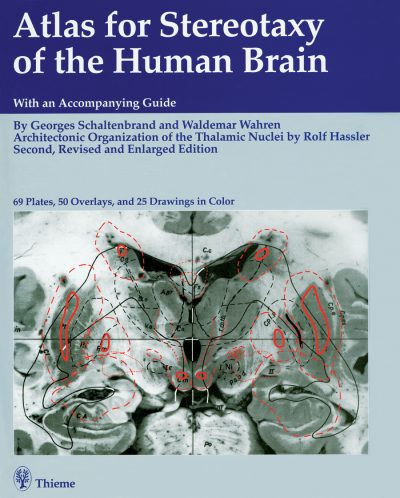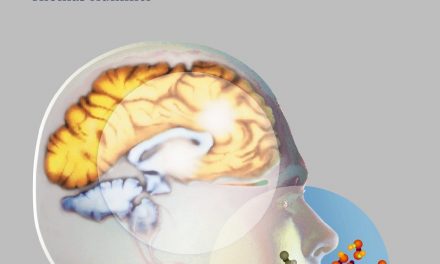Editors and Authors: Georges Schaltenbrand, and Waldemar Wahren, with the cooperation of L.V. Amador and I.A. Blundell
Publisher: Thieme – 84 pages (with 69 plates, 50 film overlays and 25 drawings in color)
Book Review by: Nano Khilnani
This extra large (14” wide x 16.5” long x 3” thick) four-ring binder containing drawings of many parts of the brain, is a unique asset for neurologists and neurosurgeons. In it, the authors – Drs. Schaltenbrand and Wahren – have utilized stereotaxy to present detailed images. Stereotaxy is a precise method of identifying non-visualized anatomic structures by the use of three-dimensional coordinates. It is frequently used for brain and spinal surgery.
A small booklet of 26 pages comes with this ring binder and functions as a useful guide, including providing a list of topics covered in this valuable binder with the very large plates. On the Contents page of this booklet you will find the following as an overview:
- Materials and Methods
- Selection of Coordinates
- The Plates
- Nomenclature
- Contours of Ventricles and of the Skull
- Macroscopic Variation of Brain Structures
- Overlays for the Frontal Macroseries
- Overlays for the Sagittal Macroseries
- Overlays for the Horizontal Macroseries
- Coordinates of the Most Important Structures in Macroseries
- Microscopic Part of the Atlas
- Frontal Myelin Series
- Frontal Nissl Series Through the Hypothalamus
- Sagittal Myelin Sections
- Horizontal Myelin Series
- Transverse Myelin Sections Through the Brain Stem
- Electroanatomical Schemata in Parallel to the Myelin Sections
- References
In order to prepare the material for this second edition of the book, the editors and authors collected 111 brains of people ranging in age from the neonate to 86 years old. They collected them at the University of Wurzburg in Germany, the University of Lund and the Soderdjukhuset in Stockholdm, Sweden.
They kept records of each person to whom the brain belonged, including, age, cause of death, sex, skull measurements, type of skull, type of perfusion, and the amount of solution used.
The editors describe the method by which they prepared the brains for this study:
“The macroscopical sections were made by placing the brain into a specially constructed brass frame resting on a heavy glass plate. Slices of 5 millimeters in thickness were cut with a very long razor sharp autopsy knife so that the irregularities on the surface produced by the usual sawing motion were eliminated as far as possible. The brains which were collected were later with a macrotome which was adjustable so that the supporting plane could be tilted at any angle between 60 degrees and 90 degrees to the plane of the knife, allowing the sections to be cut in any desired plane.”
They then go on to explain the details on how they prepared the specimens from the coronal, sagittal, and horizontal sections. In addition, in order to avoid the possibility of shrinkage and distortion during photography (which had been observed using other methods using regular negatives and paper prints) they used glass negatives, and made measurements and tracings from the glass plates.
In order to ensure to facilitate the drawings and get correct measurements, the negatives were made in an exact one to one ratio. In order to maximize accuracy, they clarify their data collection methods by clarifying that “material that showed any pathologic process in the brain was not used in the compilation or measurement of the normal series.”
A few notes on the brains of the subjects used for this study and causes of death:
- Age distribution was similar to that of general autopsy material
- A few brains of people in late childhood and early adulthood in whom death was attributed to trauma or infection
- Highest concentration of cases were on the brains of between the ages of 45 and 65, with a leveling off after age 65 and up to age 86
- Malignant disease was the most common cause of death in the 45 to 86 age group, with the second cause being cardiac lesions – including endocarditis, myocarditis, and cardiac decompensation
- The third cause of death in terms of number were pneumonias, and the remainder included various others, such as cirrhosis, hemolytic anemias, infectious diseases (diphtheria, tuberculosis, typhoid and others), peritonitis, and postsurgical complications
This is a unique atlas for neurologists and neurosurgeons, with detailed imaging using the stereotactic method, which enables unusual, highly valuable three-dimensional views.
Editors and Authors:
Prof. Dr. Georges Schaltenbrand
Facharzt fur Nervenkranheiten
Wurzburg, Germany
Prof. Dr. Waldemar Wahren
Chefarztder Neurologischen Klinik
des Oldenburgischen Landeskrankenhauses Sanderbusch
Sande / Oldenburg, Germany
With the cooperation of: L.V. Amador and I.A. Blundell







